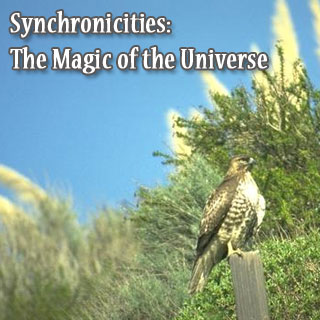 Since ancient times humans have attempted to explain coincidences, those random events that somehow seem connected. Mark Twain was fascinated by the phenomenon and kept personal writings about incidents that he called mental telegraphy. He believed that individuals were sending what we might now call telepathic messages to each other, consciously or unconsciously.
Since ancient times humans have attempted to explain coincidences, those random events that somehow seem connected. Mark Twain was fascinated by the phenomenon and kept personal writings about incidents that he called mental telegraphy. He believed that individuals were sending what we might now call telepathic messages to each other, consciously or unconsciously.
About a decade later in the early 1900’s, the biologist Paul Kammerer tried to explain the concept as seriality. He believed that somewhere, somehow things were connected and had set themselves up to happen in a certain order. His theory was not received well, but Swiss psychologist, Carl Jung, did take Kammerer’s thinking into account when he formed his own theory on what he called synchronicities. Jung toyed with this idea first in the 1920’s, but, fearing ridicule, did not actually write about synchronicities until 1951. Jung formulated his theory after many discussions with Nobel Prize winning physicists Albert Einstein and Wolfgang Pauli. On his final paper, Jung collaborated with Pauli, who is considered to be one of the pioneers of quantum physics. (A coincidence?)
Jung described synchronicity as a meaningful coincidence but with no obvious cause. He theorized that these events happen because we are all connected through the collective unconscious. “The collective unconscious is common to all; it is the foundation of what the ancients call the ‘sympathy of all things…” The roots of the word synchronicity actually mean something is together at the same time, which doesn’t really match how we experience it in linear time. (Perhaps after discussions with Pauli and Einstein, Jung knew something we didn’t about the reality of time.)
The Simplest
Many have attempted to find an explanation for coincidences. Failing to find an actual cause, they have gone on to categorize them. The simplest form of these is a single incident. It seems to have a distinct beginning and end. A common example of this is when you think of someone you haven’t talked to in a long time and suddenly they call you. My son and I rarely email each other, but it is quite common that when we do, our emails pass in the ether and land in each other’s boxes one within minutes of the other. (Mark Twain’s mental telegraphy, perhaps?)
Another example happened recently. I had a group of people over for a class and two of us were talking in the kitchen during lunch. She asked me if the wolf was my power animal because I had a picture of one on my refrigerator. I explained that while I was quite drawn to wolves, it was the hawk that first appeared as my power animal years ago. We then went out onto the back patio, and at that moment a hawk landed on my back fence and stared at us for several minutes. I have lived in my house for 22 years and have never seen a hawk even fly overhead, much less land on the fence and study me. What a thrill!
Some synchronicities show up in a form described as strings. These present themselves over and over again. This would be like the theory of seriality described by Paul Kammerer which was criticized because it was argued that we simply pay attention to that which is meaningful to us at any given time. An example of this is when I first heard the quote by Pierre Teilhard de Chardin, “We are not human beings having a spiritual experience. We are spiritual beings having a human experience.” I’d never heard the quote before, but I felt a great need to write it down, which I did. Over the next few days, I heard this quote or read it several more times. It was as if the universe was trying to make a point, sending me a message and being very sure that I heard it.
Whether you call them coincidences or synchronicities, it’s all the same. According to Robert Moss, author of the Three Only Things – Tapping into the Power of Dreams, Coincidence & Imagination, the word coincidence has gotten a bad rap because we so often say, “It’s only a coincidence.” Moss believes that we should just call it like it is, and I agree there is no only about coincidences.

